And tasty they are, too. At least the ones my team and our classmates made for our International Cuisine project. I got up in front of my sketchily-inaccurately drawn map of Denmark and chatted, nattered, and flapped about, about the land of the Danes (I often think of Denmark as the meeting point of my people — my people being the Germans and the Swedes). I talked about their history — ancient to say, WWII. I also talked about the culture and, most importantly, for our purposes, the cuisine. Danish food rings as home cooking for me. Apples, plums, pork (and pork products, of course), rice pudding, fruit sauce, open-faced sandwiches with all manner of lovely things (and admittedly things I don’t personally find lovely such as aspic and raw egg yolks), hearty soups, delicious pastries and all those kinds of things that make a girl warm and fuzzy on the inside when the outside is cold and drizzly.
J.S. talked about the cheeses of Denmark, of which there are many. We had a color handout of a photograph of Danish cheeses that my mother found for me in a brochure entitled “Say, ‘Danish Cheese Please’!” published in the 1970s. It was in her cabinet of wonders. My mother is one of those people whom you can ask, “Do you have a sproket for a 1913 widget made in Outer Slabovia?” and she will cock her head and say, “You know, I think I have one in the cabinet/basement/attic/closet/shed.” Trust me, I am not exaggerating.
We also did a mini cheese tasting of three Danish cheeses (all imported). We tasted two Harvartis. One was a triple cream that tasted almost like butter and the other was a Harvarti with caraway seeds. I always thought that my appreciation for caraway must be genetic but my dad thought caraway seeds (along with peas, Buicks and lima beans) were inedible. The third cheese was a creamy Danish blue that had that yummy-stinky cheese thing going that you can’t really describe to non-cheese lovers.
Our menu consisted of a demo of rosehip soup. H.A. demo-ed it and made it taste like something I would want to eat on a sticky summer afternoon on a terrace with a glass of wine and some friends… I did wonder if it was going to be edible. My rosehip experience is mainly of jams and Vitamin C tablets.
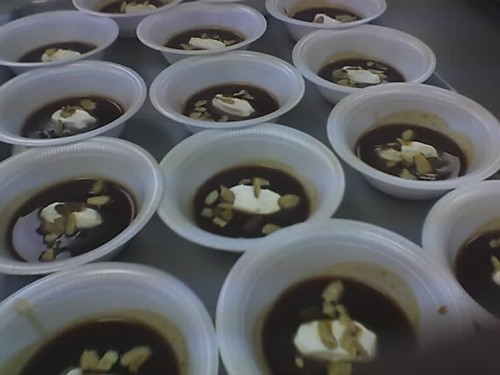
The two Ws made yellow-split pea soup from the Age Old Recipe… It was perfectly smooth in texture and very tasty in taste with just enough salt and a little creaminess from the sour cream and a little crunch from the crispy bacon.
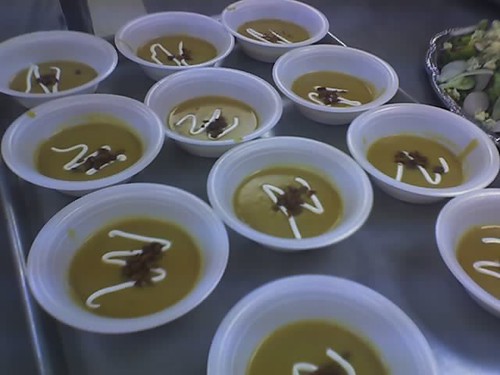
The salad showcased the blue cheese from our tasting and quick-pickled cucumbers that are so prevalent in all the recipes we looked at. The butter lettuce made it. I loathe iceberg lettuce. I know it isn’t evil or anything but it just reminds me of every bad salad through which I have had to suffer. Mom and Dad did grow it in their garden one year and I will happily admit that it didn’t taste like the slickly bleached out stuff on your average salad bar. It was sweet and crunchy and I had a fleeting glimmer of why people like iceberg lettuce, that it could be something more than a vehicle for ranch dressing (shudder).

Our main dish was a pork loin stuffed with prunes and apples with a red currant jelly and cream sauce. I know it sounds a little odd, but it was amazingly moist and moreish. We served it with Hasselback potatoes. Not the most Danish thing on the menu but I felt like they were very Scandinavian and people would be more excited by them than boiled potates.
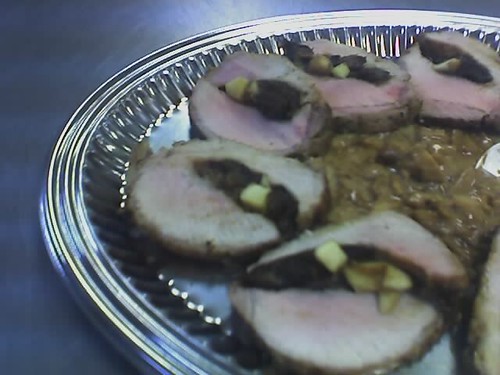
We also made snitter, which is a miniture smørrebrød, the Danish for open-faced sandwich. We stuck with a simpler sandwich that we found in my giant Culinaria: European Specialities. It consisted of rye bread slathered with Lurpak Dainsh butter, layered with smoked salmon and blanched asparagus and topped with hard-cooked eggs and dill sprigs. I think they may have been my favorite thing on the menu.
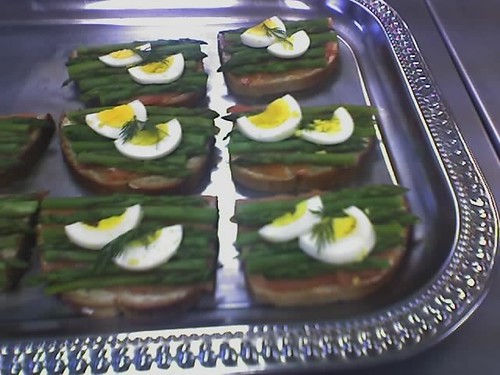
For dessert we made rice pudding with a red fruit sauce. V., our classmate who made it, found the almond that was hidden in the pudding which according to legend means he should have a series of lucky adventures. Not a bad little tradition and the almond is less likely to ruin your dental work or stick in your throat than a silver coin or plastic baby.
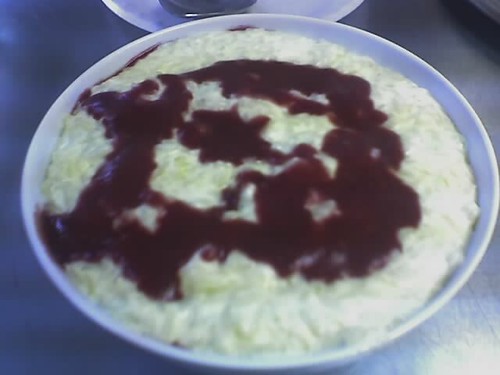
All and all, I was pretty pleased with our project. I worried about timing and scheduling but I felt like everybody worked at making it great. Overall, Int’l was one of the most fun classes of culinary school. The food geek in me loves learning about all the different ingredients and I have a fat folder of new recipes from all over the world. On Tuesday, we are all going out to eat Vietnamese as our “final”. Not a bad way to end the semester.
In the event that you might like to have a Danish night at your hus, here are the recipes for everything except the rosehip soup:
A Danish Menu
Danish Open-Faced Sandwich Smørrebrød
Yield: 4 sandwiches
Open-faced sandwiches are the national dish of Denmark. There are even special carriers made so Danes can take homemade open-faced sandwiches as a packed lunch.
4 slices dark rye bread
2 Tablespoons Lurpak lightly salted butter, softened
8 oz thinly sliced smoked salmon
4 3” spears asparagus, blanch and halved length-wise
2 hard-cooked eggs, quartered
dill sprigs, for garnish
Divide the butter evenly between the slices of bread and spread in a thin layer that completely covers the top side of the bread. Layer the smoked salmon over the butter, arranging the salmon so it completely covers the bread mostly without overlapping. Arrange the asparagus spears and egg quarters on each sandwich and garnish with a sprig of dill.
Yellow Split Pea Soup
Yield: approx 6 cups
This soup is eaten throughout Scandinavia. In Sweden and Finland, especially, it is eaten every Thursday, a tradition dating to the pre-Reformation era and believed to be a preparation for fasting on Friday.
8 Cups water
approx 4 oz piece salt pork or slab bacon
1 pound yellow split peas, picked over and rinsed
1 large carrot, medium dice
1 medium onion, medium dice
2 large cloves of garlic, minced
1 bouquet garni
salt and pepper
sour cream, to garnish
Combine water, pork and peas in a soup pot and bring to a boil. Reduce to a simmer and cook for one hour. Add vegetables and bouquet garni and simmer until peas are tender, approximately one hour. Check seasoning. Remove bouquet garni and salt pork, reserving pork. Using a stick blender or food processor, puree soup smooth. Dice reserved pork or bacon and sauté crisp. To serve, ladle into warmed bowls and garnish with a swirl of sour cream, crispy bacon and a sprinkling of coarsely ground pepper.
Danish Pickled Cucumbers Syltede Aqurker
Yield: approx 6 servings
These are popular as a relish with meals and show up in salads and as a topping for open-faced sandwiches.
2 medium cucumbers, thinly sliced
1/3 cup cider vinegar
1/3 cup water
2 tablespoons sugar
½ teaspoon salt
1/8 teaspoon ground pepper
Snipped dill weed or parsley
Place cucumbers in a glass or plastic bowl (do not use metal as it may impart off-flavors to the pickles). Mix vinegar, water, sugar, salt and pepper and pour over cucumbers. Cover and refrigerate, stirring occasionally, at least three hours. Drain and sprinkle with dill weed or parsley.
Blue Cheese Salad
Yield: 4 servings
Danes are especially known for the quality of their cheeses, Danish Blue being among the most famous.
Pinch each: salt, pepper, dry mustard and sugar
2 tablespoons wine vinegar
4 tablespoons light tasting oil
1 quart butter lettuce leaves, washed, dried and torn into bite-sized pieces
1 small bunch baby radishes, thinly sliced
1 recipe Danish pickled cucumbers
1 sweet onion, thinly sliced
¼ pound crumbled Danish blue cheese
To make the dressing, in a small bowl, mix together salt, pepper, dry mustard, sugar and vinegar. Whisk in the oil. Just before service, toss the lettuce with the dressing.
To make one large salad, place lettuce in a bowl large enough to accommodate or lay out on a platter. Arrange the radishes, pickled cucumbers and onions and sprinkle with crumbled cheese.
Hasselback Potatoes
Yield: 6 servings
Hasselback potatoes are traditional to Sweden but have been adopted throughout Scandinavia. For Christmas especially, Danes caramelize boiled potatoes in a butter and sugar mixture.
6 baking potatoes, about 4 inches long and 2 inches wide
3 tablespoons melted butter
1 teaspoon salt
2 tablespoons dry breadcrumbs
Preheat the oven to 425°F. Peel the potatoes and keep in a bowl covered with water. Place one potato at a time on a wooden spoon large enough to cradle it comfortable, and beginning at about ½” from the end slice down the potato at 1/8” intervals without slicing through the potato completely, the bowl of the spoon helps in doing this. Drop the sliced potato back into the water while slicing the others.
When all potatoes are sliced, drain and pat them dry. Generously butter a baking dish and arrange the potatoes in one layer. Baste the potatoes with 1 ½ tablespoons of the melted butter and sprinkle them liberally with salt. Roast them in the center of the oven. After 30 minutes sprinkle the bread crumbs over the surface of each potato and baste with the remaining butter and any butter in the pan. Continue to roast for another 15 minutes or until the potatoes are golden brown and show no resistance when pierced with the tip of a sharp knife.
Pork Loin Stuffed with Apples and Prunes Mørbrad med Svedskar og Aebler
Yield: 6-8 servings
Pork is by far the favorite meat of the Danish and pork is one of the country’s largest exports.
4 ½?5# boned loin of pork, center cut if possible
12 medium-sized pitted prunes
1 large tart apple, peeled, cored and cut into 1” cubes
1 teaspoon lemon juice
salt
freshly ground black pepper
3 tablespoons butter
3 tablespoons vegetable oil
¾ cup dry white wine
¾ cup heavy cream
1 tablespoon red currant jelly
Place prunes in a saucepan, cover with cold water and bring to a boil. Remove from the heat and let prunes soak in water for 30 minutes. Drain the prunes, pat dry with paper towels and set aside. Sprinkle the cubed apple with the lemon juice and set aside. With a strong, sharp knife, make a pocket in the pork by cutting a deep slit down the length of the loin, going to within a ½” of the ends and to within 1” of the other side. Season the pocket lightly with salt and pepper and stuff it with the prunes and apples. Tie the loin at 1” intervals to keep the stuffing in and retain the shape while cooking. Season the outside of the roast.
Preheat the oven to 350°F. In a pan that can go into the oven and is big enough to just fit the roast, melt the butter and oil over moderate heat. When the foam subsides, add the loin, turning it to brown on all sides. Set the meat aside and drain all fat from the pan. Deglaze with wine and stir in the heavy cream. Bring to a simmer place the meat back into the pan, cover and place in the oven. Cook until meat reaches 135°F degrees.
Remove the loin from the pan and let rest on a heated platter, covered, while finishing the sauce.
Skim the fat from the liquid in the pan and bring the liquid to a boil. When it has reduced to about 1 cup, stir in the red currant jelly, reduce the heat and, stirring constantly, simmer briefly until the jelly is melted and sauce is smooth. Taste for seasoning and keep warm.
To carve the roast, cut the strings and slice the roast into 1” slices. To serve, pour one or two tablespoons of sauce onto a heated plate and arrange the slice of roast over it to display the stuffing.
Danish Christmas Rice Pudding with Raspberry Sauce
Yield: 6-8 servings
This pudding is traditionally served on Christmas Eve with one almond hidden in the dessert. The recipient of the almond is guaranteed good luck in the New Year.
For Pudding:
¾” cup uncooked short- or medium-grained rice
½ teaspoon salt
2 cups heavy cream
2 cups milk
2 eggs, beaten
1 tablespoon butter
1/3 cup sugar
½ teaspoon freshly ground cardamom
1 3” stick cinnamon
1 whole almond
Preheat the oven to 325°F. Butter a two-quart casserole dish.
Bring 1 ½ cups water to a boil. Add rice and salt. Cover and simmer over low heat for 10-15 minutes, until the rice has absorbed the water. Add the cream, milk, eggs, butter, sugar and cardamom to the rice. Turn the mixture into the prepared casserole. Poke the cinnamon stick into the rice and hide the almond in the pudding.
Set the casserole into a larger pan and pour boiling water into the larger pan so that it reaches halfway up the edge of the casserole. Bake for 2 hours, or until the rice swells and has a creamy texture.
For Sauce:
1 10 oz. package frozen raspberries, thawed
½ cup apple or red currant jelly
1 tablespoon cold water
1 ½ teaspoon cornstarch
In a saucepan, bring raspberries with the juice and jelly to a boil. Make a slurry with the water and cornstarch and stir into the raspberries. Bring to a boil again, stirring constantly for 1 minute. Keep warm.
Serve pudding warm or chilled with warm sauce.

Thank you for all the good sounding recipes. We were at a Danish club for their Christmas party once and loved the Danish rice pudding with red currant jelly in it an the almond hidden in it. We wanted t make it for our church social, we have a little gift for the winner who finds the almond, a great tradition. Thank you much. Merry Christmas from Arizona.
We also loved the Danish Yellow Pea Soup….Can’t wait to try out the other recipes as well. Happy eating.